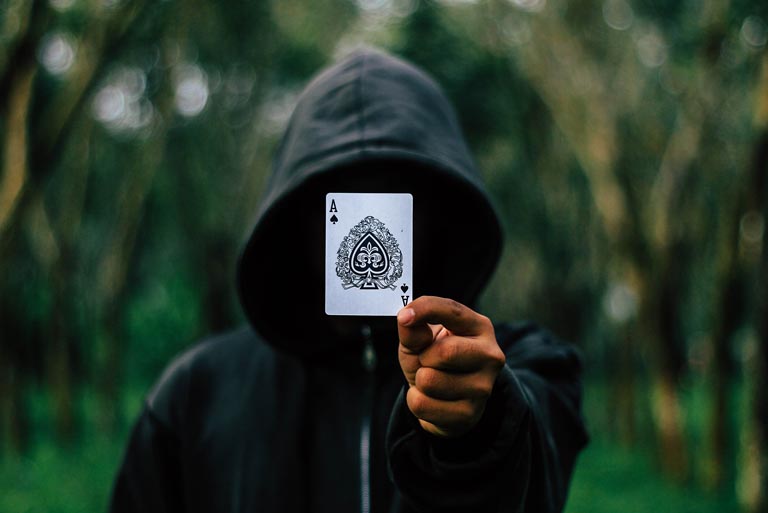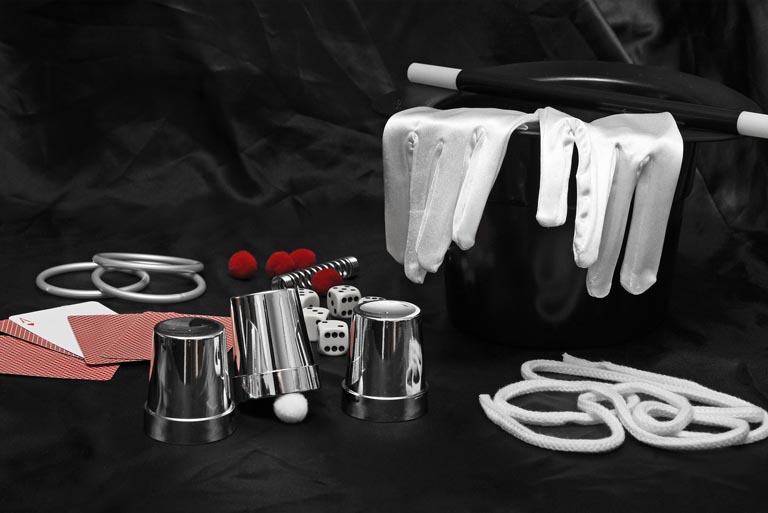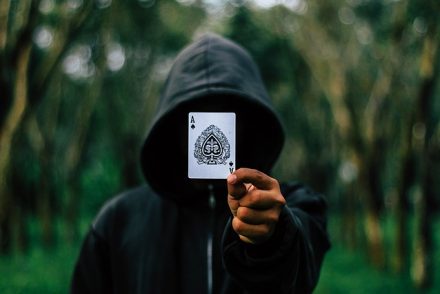If you are ready to follow in the footsteps of John Henry Anderson, Alexander Herrmann, Harry Houdini, Siegfreid and Roy, Penn and Teller, David Copperfield, and Derren Brown, be prepared to work hard to develop your skills and showmanship. Choose one of your favorite types of magic and get busy.
Everyone loves a good magic trick or illusion. When a practitioner makes something vanish or suddenly appear, or when a magician seems to be able to read someone’s mind, the audience is thrilled and mystified. It really seems as if some supernatural power is at play. Magic practitioners know, however, that they are creating illusions.
As a practitioner, you will likely develop expertise with one, or perhaps two, or maybe three, types of illusion. However, there are at least eight key types of magic that every illusionist ought to be familiar with. Combining a variety of types of magic will wow your audience and make your show legendary.
What Is Magic?

Image Source: Pixabay
Here at rebelmagic.com, we aim to provide you with the best information and direction in developing your magic skill. But we are not dealing in the dark arts of alchemy or other arcane hidden legacies. We want to assist you in developing the skills of the illusionist or the art of performance magic no matter what types of magic and illusion you want to master.
Magic is the art of creating believable illusions that seem to defy the common laws of physics. Whether you are making things appear or disappear, destroying objects and then restoring them, or passing objects through one another, you are creating illusions. The same is true when you are creating the illusion of being able to read someone’s mind, or of knowing about things you shouldn’t rightfully know.
Our magic is a performing art for entertainment. We want to help you master sleight of hand, close-up magic, apparent mind reading or psychic abilities, and even comedy magic. And while there are many basic skills to master in magic performance, there are eight main types of magic you’ll want to be familiar with.
History

Image Source: Unsplash
Performance magic has been popular in small venues for as long as people have gathered in fairs and festivals. It seems that people have always enjoyed watching a performance that challenges their sense of reality.
But the use of illusion has not always been innocent or merely entertaining. The sleight of hand and close up magic skills that are so entertaining have also been used to cheat at gambling or to con people out of money.
Since the late 19th century, performance magic has become a standard of larger venues such as stage shows, Broadway, and vaudeville. And since the advent of television, the art of illusion has made an easy transition to the airwaves. Grand television illusions, such as David Copperfield making the Statue of Liberty vanish, appeal to huge audiences, even though people understand that they might be being tricked.
Magic shows are said to have been started by Pairs clockmaker Jean Eugene Robert-Houdin — whose name was borrowed later by the famous Harry Houdini. Robert-Houdin opened a magic theater in Paris in 1845. At the same time, Englishman John Henry Anderson was drawing crowds in London with his alluring advertisements and grand showmanship.
Magic shows are always popular when they are well done. And as audiences have become more sophisticated, the illusions have gotten grander and grander. Think, for example, of the television performances of Doug Henning and David Blaine.
Even more recently, in addition to close-up magic and stage magic, we have seen the beginnings of computer magic. Some of these illusions, like Esmerelda’s Crystal Ball, have convinced people that their computers have psychic powers.
What Types of Magic Should I Learn?

Image Source: Unsplash
You’ll want to be familiar with all eight types of magic, but you’ll probably specialize in only one or two.
Think about the practitioners you enjoy watching. Do you absolutely love it when someone appears to have access to supernatural information? Or are you fascinated with objects turning up suddenly where they have no right to be? Maybe you’re particularly drawn to magicians who manipulate objects which seem to pass through each other in defiance of logic or objects which transform from one form to another.
You’ll also need to decide whether you want to focus your skill building on close-up illusions or on stage magic. Do you want to work with cards, coins, fire, or birds, for instance? Do you want to amaze your audience with your apparent clairvoyance or with the skill of your hands? Or do you want to go really big like some of the more notable practitioners such as David Copperfield, David Blaine, or Derren Brown? The possibilities are endless, but the dedication to practice and mastery are the same.
Successful illusions depend upon excellent skills no matter which types of magic you are learning to perform. There are handling skills, like being able to hold an object undetected in your hand. There are skills involved in using specialized equipment—without the audience knowing how that equipment works. And there are performance and showmanship skills to be mastered.
8 Types of Magic For Practitioners
As you’re thinking about the types of skills you want to master, think about these eight basic types of magic.
Vanishing Illusions
Do you want to make a coin suddenly disappear? How about a larger object like a person, or even a car? There are specific skills that practitioners employ in any vanishing illusion. You’ll want to master the basics of sleight of hand and of deflecting the attention of your audience in order to become proficient in vanishing magic.
Vanishing illusions are one of the types of magic that are often combined with appearance illusions or restoration tricks. One moment, an object vanishes or gets destroyed, the next it reappears or appears whole again.
Appearance Illusions
Appearance tricks involve making something suddenly appear out of nowhere. The classic trick of finding a coin behind Grandma’s ear that your uncle performed at Thanksgiving dinner is an example. Another example is when a magician pulls a rabbit out of a hat.
Appearance magic also includes changing the form of objects: turning a scarf into a bird, changing the color or appearance of a cloth, a wand or other object, making a whole deck of cards appear where it seemed there was only one card, or making a card appear wherever you want in the middle of a deck.
Appearance tricks take a lot of practice. The practitioner needs to excel in deftly handling objects and in diverting the audience’s attention away from the sleight.
Levitation
Levitation tricks make objects appear to rise off a surface or to float in thin air. These gravity-defying illusions are popular and mystifying. They challenge an audience’s sense of reality and seem to disrupt a physical law—gravity—that most people never question. This makes levitation illusions powerful audience pleasers.
Maybe you want to float objects through space or lift yourself or other people off the ground. There are a certain set of skills you must master to be able to do this without detection.
Levitation illusions can be as simple as the classic Indian Rope Trick or as complex as making your assistant float up off a perch on stage. Levitation tricks can also be done close up with proper practice and skill.
Passing Through
Push an object through a card or scarf without leaving a hole. Press a coin through someone’s hand. Work with classic rings or wands that seem to pass magically through each other.
Or do you want to walk through an object the way David Copperfield walked through the Great Wall of China? These are popular illusions that leave an audience scratching their heads.
It is important to master the skills involved in deflection of attention to be proficient in Passing Through illusions. And it helps to cloak your moves in grand showmanship too. The audience must not see what you are really doing, but their attention must be directed where you want it to be.
Transportation
Transportation is one of the most common illusions and it takes many forms. When you move an object into an unexpected place, say into someone’s pocket, behind someone’s ear or even in a sealed container, you are practicing transportation.
People learn object permanence as small children. We expect things to stay where we last saw them. It is a delightful surprise to an audience when a practitioner seems to violate the laws of physics and move objects into unexpected places.
Transportation is always mystifying to an audience and requires the mastery of a specific set of skills.
Mind Reading or Mentalism
Mind readers seem to be able to read the thoughts of others—to be able to tell what objects or people the other person is thinking of. This is always astonishing to watch. Mind reading performances are often dressed up with dramatic music and mystical stage settings to enhance the audience’s belief that there is something supernatural going on.
But mind reading also includes a practitioner being able to influence a person to respond in a predictable way. Derren Brown is the most notable of these experts. He subtly plants suggestions in his banter with his audience that lead them to think of exactly what he wants them to think of. This skill is akin to hypnotism and uses the scientific principle of mental suggestion to implant ideas into the thoughts of another.
Mind reading is an absolutely crowd-pleasing act. Audiences like to be shaken by the seemingly impossible, and one of the ideas most people hold dear is that their thoughts are private. Mind reading acts challenge this assumption.
Restoration
When a magician takes your valuable watch and crushes it to pieces, or takes your hundred-dollar bill and rips it to shreds, you better hope that he or she has mastered the art of restoration. Of course, the practitioner never ruined your cherished object in the first place, but when a restoration illusion is performed by a master, you will never see when or how the switch takes place.
Simple restoration illusions include restoring torn paper or cloth back to its undamaged state and restoring to wholeness someone you appeared to saw in half.
Even though most viewers know, in the backs of their minds, that the object was never destroyed, cut, torn or mutilated, they still love to see the restoration. There is something satisfying for an audience in seeing something made whole again.
Escapology
Popularized by Harry Houdini, this type of magic involves daring escapes from impossible situations. When a performer has him or herself locked in chains and immersed in water, the illusionist counts on the rising anxiety of the audience to enhance the effectiveness of the illusion. Most escape artists are adept at picking locks, holding their breath, and other body manipulations, such as contortionist-level joint movements, that allow them to escape their bindings.
Escapology is one of the more specialized types of magic that sometimes require collaboration from the audience or specialized equipment.
Related to Escapology are illusions that require specialized body training, such as sword, or glass swallowing or lying on sharp objects like a bed of nails. These illusions are dangerous and their practitioners go through a hefty amount of training and skill building.
Conclusion

Image Source: Pixabay
Magic is popular because it challenges our assumptions about reality. A good illusion forces us to question basic assumptions we have about how life works. We all love to be fooled, to imagine, at least for a few minutes, that life is more mysterious than it seems to be in our day-to-day activity.
And yet, people are generally skeptical and hard to fool, so a good magic practitioner has to be dedicated to excellence. There are very specific skills that need to be mastered for the illusions to be successful. You will find the support you need to master your craft here at rebelmagic.com. Being an excellent illusionist is a rewarding experience. Yes, it takes dedication and lots and lots of practice, but the art of astonishing an audience is well worth the effort.


